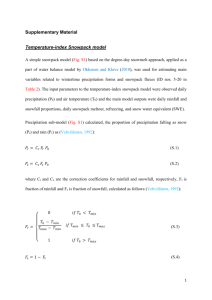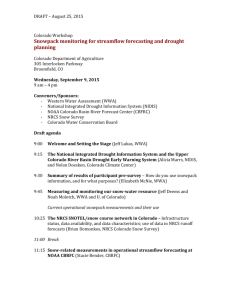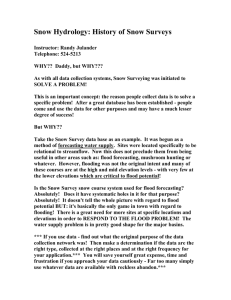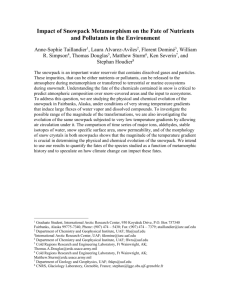A MODIFIED FORCE-RESTORE APPROACH TO MODELING SNOW-SURFACE HEAT FLUXES ABSTRACT
advertisement
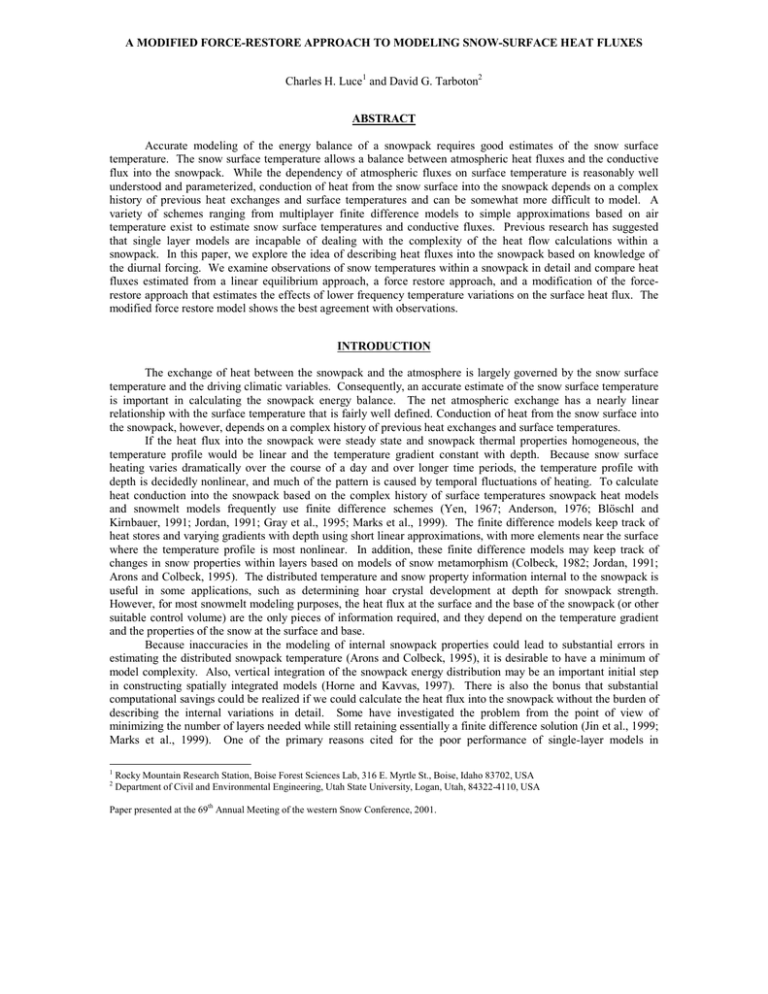
A MODIFIED FORCE-RESTORE APPROACH TO MODELING SNOW-SURFACE HEAT FLUXES Charles H. Luce1 and David G. Tarboton2 ABSTRACT Accurate modeling of the energy balance of a snowpack requires good estimates of the snow surface temperature. The snow surface temperature allows a balance between atmospheric heat fluxes and the conductive flux into the snowpack. While the dependency of atmospheric fluxes on surface temperature is reasonably well understood and parameterized, conduction of heat from the snow surface into the snowpack depends on a complex history of previous heat exchanges and surface temperatures and can be somewhat more difficult to model. A variety of schemes ranging from multiplayer finite difference models to simple approximations based on air temperature exist to estimate snow surface temperatures and conductive fluxes. Previous research has suggested that single layer models are incapable of dealing with the complexity of the heat flow calculations within a snowpack. In this paper, we explore the idea of describing heat fluxes into the snowpack based on knowledge of the diurnal forcing. We examine observations of snow temperatures within a snowpack in detail and compare heat fluxes estimated from a linear equilibrium approach, a force restore approach, and a modification of the forcerestore approach that estimates the effects of lower frequency temperature variations on the surface heat flux. The modified force restore model shows the best agreement with observations. INTRODUCTION The exchange of heat between the snowpack and the atmosphere is largely governed by the snow surface temperature and the driving climatic variables. Consequently, an accurate estimate of the snow surface temperature is important in calculating the snowpack energy balance. The net atmospheric exchange has a nearly linear relationship with the surface temperature that is fairly well defined. Conduction of heat from the snow surface into the snowpack, however, depends on a complex history of previous heat exchanges and surface temperatures. If the heat flux into the snowpack were steady state and snowpack thermal properties homogeneous, the temperature profile would be linear and the temperature gradient constant with depth. Because snow surface heating varies dramatically over the course of a day and over longer time periods, the temperature profile with depth is decidedly nonlinear, and much of the pattern is caused by temporal fluctuations of heating. To calculate heat conduction into the snowpack based on the complex history of surface temperatures snowpack heat models and snowmelt models frequently use finite difference schemes (Yen, 1967; Anderson, 1976; Blöschl and Kirnbauer, 1991; Jordan, 1991; Gray et al., 1995; Marks et al., 1999). The finite difference models keep track of heat stores and varying gradients with depth using short linear approximations, with more elements near the surface where the temperature profile is most nonlinear. In addition, these finite difference models may keep track of changes in snow properties within layers based on models of snow metamorphism (Colbeck, 1982; Jordan, 1991; Arons and Colbeck, 1995). The distributed temperature and snow property information internal to the snowpack is useful in some applications, such as determining hoar crystal development at depth for snowpack strength. However, for most snowmelt modeling purposes, the heat flux at the surface and the base of the snowpack (or other suitable control volume) are the only pieces of information required, and they depend on the temperature gradient and the properties of the snow at the surface and base. Because inaccuracies in the modeling of internal snowpack properties could lead to substantial errors in estimating the distributed snowpack temperature (Arons and Colbeck, 1995), it is desirable to have a minimum of model complexity. Also, vertical integration of the snowpack energy distribution may be an important initial step in constructing spatially integrated models (Horne and Kavvas, 1997). There is also the bonus that substantial computational savings could be realized if we could calculate the heat flux into the snowpack without the burden of describing the internal variations in detail. Some have investigated the problem from the point of view of minimizing the number of layers needed while still retaining essentially a finite difference solution (Jin et al., 1999; Marks et al., 1999). One of the primary reasons cited for the poor performance of single-layer models in 1 2 Rocky Mountain Research Station, Boise Forest Sciences Lab, 316 E. Myrtle St., Boise, Idaho 83702, USA Department of Civil and Environmental Engineering, Utah State University, Logan, Utah, 84322-4110, USA Paper presented at the 69th Annual Meeting of the western Snow Conference, 2001. comparative validations is poor representation of internal snowpack heat transfer processes (Blöschl and Kirnbauer, 1991; Koivasulo and Heikinheimo, 1999). They have also specifically cited the errors being most pronounced during cold periods before melt occurs, indicating that heat flow more than water flow may be to blame. This raises the question of whether single-layer representation of the snowpack is a feasible goal or, phrased another way, whether the models examined had errors in the specific derivation of their single-layer approach that can be overcome. Given that the source of the strongest nonlinearities in the snowpack temperature profile are daily temperature fluctuations at the surface, which have an approximately sinusoidal pattern, it seems reasonable to use this to formulate a solution to the surface and basal heat fluxes for a single-layer snowmelt model. The force-restore approach to estimating snow surface heat flux (e.g., Deardorff, 1978; Dickinson et al., 1993; Hu and Islam, 1995) assumes that the driving flux at the surface is sinusoidal. Such an assumption may allow for significant simplification of heat flow modeling compared to finite difference procedures, while still retaining important information about the process. THEORY We can describe heat flow in the snowpack approximately using the diffusion or heat equation and assuming homogeneity of properties (Yen, 1967), ∂T ∂ 2T =k 2 dt ∂z (1) where T is the temperature (C), t is time (s), z is depth (m) measured downwards from the surface, and k is the thermal diffusivity (m2 s-1). Thermal diffusivity is related to thermal conductivity and specific heat through k = λ/Cρ where λ is the thermal conductivity (J m-1 K-1 s-1), C is the specific heat (J kg-1 K-1), and ρ is the density (kg m-3). For semi-infinite boundary conditions (0 < z < ∞) with a sinusoidal temperature fluctuation at the upper boundary, the differential equation (1) has a solution (Berg and McGregor, 1966) T ( z , t ) = T + Ae − z d1 z sin ω1t − d 1 (2) In this solution, A is the amplitude of the diurnal temperature fluctuation at the surface (C), T is the time average temperature at the upper boundary (C). d1 is the diurnal damping depth, the depth at which the amplitude is 1/e times the surface amplitude and is related to the diffusivity and frequency by d1=(2k/ω1)1/2. ω1 is the diurnal frequency (radians s-1), where the subscript 1 denotes one day. The heat flux is the thermal conductivity times the temperature gradient z Qc ( z , t ) = −λ ∂T λA − d1 z z = e sin ω1t − + cos ω1t − = ∂z d1 d1 d1 z 2λA − d1 z π e sin ω1t − + d1 d1 4 (3) and the surface heat flux is Qcs = −λ λA dT ( 0, t ) = [sin(ω1t ) + cos(ω1t )] = dz d1 π 2 Aλ sin ω1t + 4 d1 (4) showing that the temperature lags the heat flux by π/4 radians, which is 1/8 of a cycle or 3 hours. Here Qc and Qcs are defined as positive in the positive z direction which is into the snow. From equation 3, recognizing that ωcos(ωt) is the derivative of sin(ωt), and substituting equation 2 we can express the heat flux Qc ( z , t ) = λ 1 ∂T ( z , t ) + T ( z, t ) − T d1 ω1 dt (5) This is the basis for the force restore method to estimate the surface heat flux (c.f. equation 10 of Hu and Islam, 1995). Applied at the surface and using a finite difference approximation for ∂Ts / ∂t results in an estimate Qcs = ( ) λ 1 Ts − Tslag 1 + (Ts − T ) d1 ω1∆t (6) where ∆t is the measurement interval, Ts is the surface temperature, and Tslag1 is the surface temperature lagged by one time step, i.e. at t-∆t. While T is identified as the time average temperature in equation 2, in typical application T is interpreted as the average temperature of the medium with depth (see Hu and Islam, 1995, for example). In this paper, we denote the depth-averaged temperature as Tave. A preview to Figure 1b shows that Equation 6 may be a poor approximation because the temperature gradient with depth does not cycle on a daily time scale. The diurnal cycle is superimposed on a strong upward temperature gradient with what appears to be a weekly time scale. Lower frequency fluctuations cause temperature variation with depth and thus heat fluxes. In fact, there may be greater power in the lower frequency variability. We can superimpose the heat fluxes due to lower frequency variability on equation 6 using the gradient in daily average temperature to estimate the net result of lower frequency variability. We roughly approximate the superimposed gradient using the difference in the daily average surface temperature, Ts , and the daily average depth average snowpack temperature (estimated from the energy state of the snowpack), Tave , over a distance dlf, the low frequency damping depth. This results in a modification of the force-restore equation to Qcs = ( ) λ λ 1 Ts − Tslag 1 + (Ts − Ts ) + (Ts − Tave ) d1 ω1∆t d lf (7) where dlf = (2k/ωlf)1/2 , associating a frequency, ωlf, with the distance dlf used in the daily average gradient estimate. The thermal properties of the snowpack are the same for both low and high frequency forcing; however, the appropriate frequency to describe the low frequency contribution, ωlf, is less clear. In this paper, ωlf is fitted to observations. Large and fast variations in the snowpack surface temperature and strong nonlinearities in the process make finding the average temperature of the top few centimeters of snow difficult. Here we superimpose the solution expressed in equation 2 onto a linear temperature gradient (i.e. T (z ) is assumed to be linear) and integrate over a layer from the surface (z=0) and a depth zb to get Tsl z − b A z d1 π = (Ts + Tb ) + sin(ω1t − 4 ) − e sin ω1t − db1 − π4 zb 2 d1 ( 1 2 ) (8) where Tsl is the depth averaged temperature of the surface layer, Ts is the time averaged surface temperature, and Tb is the time averaged temperature at depth zb (we used the 24-hour average centered on the time of interest for our application). Noting the identities for temperature at the surface and the temperature at zb, and recognizing that a phase change of -π/4 represents 3 hours earlier yields Tsl = 1 2 (T s + Tb ) + 1 [Ts (t − 3hr ) − Tb (t − 3hr ) − Ts + Tb ] 2 zb d1 (9) Equation 9 is approximate because of the assumptions regarding sinusoidal temperature fluctuations in the derivation of equation 2. Equation 9 is also in error in so far as there are lower frequency variations in temperature, i.e., Ts and Tb are not constant. Equations 1-9 present a description of how snowpack temperatures should behave if the sinusoidal forcing model is a reasonable approximation of the heat conduction processes. One of the primary clues we can use from temperature measurements in the snowpack is the relative phase and amplitude of the diurnal wave as it passes through the snowpack. Table 1 presents a brief summary for the reader’s later reference. Table 1: Theoretically Derived Relative Phase and Amplitude of Temperature and Heat Flux Observations. Measurement Relative Phase Surface Temperature φ Surface Heat Flux Temperature at z φ+π/4 φ-z/d1 Average snowpack temperature (z/d > 3) Heat flux at z φ−π/4 φ+π/4−z/d1 Relative Amplitude Equation Α 2 Aλ / d1 4 2 Ae − z / d 1 2 A λ e − z / d1 / d 1 8 3 METHODS The measurements used in this analysis were previously presented by Tarboton (1994) as part of a validation of the UEB snowmelt model (Tarboton et al., 1995). Based on that analysis, one of the problems identified was a disparity between modeled and measured energy contents indicating the need for a better parameterization of the conductive heat flux into the surface of the snowpack and prompting this study. Site Description Measurements were made west of Logan, Utah, near the center of Cache Valley, situated in the Wasatch Mountains, east of the Great Salt Lake in Utah. Cache Valley is similar to many valleys formed by faulting in the Basin and Range Province of the western United States. It is oriented north and south, about 110 km long and 15 km wide, between two high ranges on the east and west, about 2000 m higher than the valley floor, a situation making the valley prone to long winter inversions. The valley bottom is flat and is mostly covered by wetlands and related vegetation. Much of the land near the valley bottom has been converted to pasture land through the use of drainage canals. Measurements were taken at the Utah State University Research Drainage Farm, which was instrumented to measure the effects of the wetland-to-pasture conversion. The ground at the site has a loamy soil, rich in organics and a cover of short grass. Measurements Snowpack and shallow soil temperatures were measured using eight copper-constantin thermocouples and an infrared thermometer. Two thermocouples were placed below the ground surface at depths of 2.5 and 7.5 cm. Another thermocouple was placed at the ground surface, and the remaining five thermocouples were placed at 5, 12.5, 20, 27.5, and 35 cm above the ground surface on a ladder constructed of fishing line. The raw thermocouple measurements showed high frequency, large magnitude temperature variations simultaneously through the snowpack, and temperatures greater than 0°C in some cases (Figure 1a). The fact that the high frequency variations were simultaneous through such a strong insulator as a snowpack was a clue to the explanation that that the reference thermistor on the faceplate of the multiplexer gave inadequate correction for voltages created where the thermocouples connected to the metal of the multiplexer. Such voltages depend on the temperature at the connection, which evidently can vary during the day despite being in a cool box buried beneath the snow. We corrected for this by assuming that the temperature at the thermocouple 7.5 cm below the ground surface had nearly no diurnal variation and set the temperature for this thermocouple as a linear interpolation of the daily average temperature. The voltage differences between the recorded and the interpolated measurements were subtracted from the other thermocouple measurements to produce a corrected temperature trace for each thermocouple (Figure 1b). For future investigations, it would be useful to place the reference thermistor with the thermocouple lowest in the soil; then differences between thermocouple voltages can be used to estimate temperature differences between the thermistor and each thermocouple. Snowpack surface temperature was measured with two Everest Interscience model 4000 infrared thermometers with 15-degree field of view. These instruments measure upwelling longwave radiation and assume an emissivity of 0.99 to estimate the snowpack temperature. Snowpack emissivity in the longwave part of the spectrum is between 0.988 and 0.985 (Marks and Dozier, 1992). Ground heat flux was measured with a REBS ground heat flux plate placed at 10 cm depth in the soil. The heat flux plate gives heat conduction from the ground into the snowpack as positive. Analysis We examined the temperature patterns over the first 8 days of the study period to examine how well the heating and the cooling of the snowpack can be described as a sinusoidal process. We also wanted to confirm that the large phase shift and amplitude change between the surface temperature and uppermost thermocouple (about 4 cm depth) was reasonable. We used Fourier analysis to estimate the amplitude and phase of the diurnal component associated with each temperature trace. To do this, we performed a Fourier transform with a Parzen window (Press et al., 1992) spanning the full 8 days (192 hours). The amplitude, A, and relative phase, φ, of the diurnal frequency component for each temperature trace was recorded, and the differences were used to infer z/d1 from equation 2. The difference in the value of φ at one layer and the value of φ at another is an estimate of the value of –z/d1 from equation 2 for the intervening snow. Similarly, the value of z/d1 for snow between two measurements can be estimated from the natural log of the ratios of the amplitude of the lower measurement to the amplitude of the upper measurement. Knowing the vertical position of each measurement in the snowpack, we obtained an estimate of d1, which was used along with the measured average snowpack density of 0.4 Mg/m3 and specific heat of ice, 2.09 kJ/kg, to estimate the conductivity, λ. a) 1.00 -1.00 Temperature (C) -7.5 cm -2.5 cm 0.0 cm -3.00 5.0 cm 12.5 cm 20.0 cm 27.5 cm -5.00 35.0 cm -7.00 -9.00 1/26 0:00 b) 1/28 0:00 1/30 0:00 2/1 0:00 2/3 0:00 2/5 0:00 2/7 0:00 2/9 0:00 0 -5 -7.5 cm Temperature (C) -10 -2.5 cm 0.0 cm 5.0 cm -15 12.5 cm 20.0 cm 27.5 cm 35.0 cm -20 Surface -25 -30 1/26 0:00 1/28 0:00 1/30 0:00 2/1 0:00 2/3 0:00 2/5 0:00 2/7 0:00 2/9 0:00 Figure 1: a) Raw thermocouple traces and b) corrected thermocouple traces. Note that warmer temperatures correspond to deeper thermocouples; legend mimics sequence of lines in the graphs. The energy content of a control volume comprising the snow and soil above the heat flux plate buried at 10 cm was estimated from the average snowpack temperature, the average soil temperature, and the snowpack surface temperature. For layers of the snowpack and soil between thermocouples, we used the average temperature between the thermocouples. The average temperature of the top layer from the surface to the first thermocouple was calculated from equation 9. Taking 0°C ice as having 0 energy content, for U < 0, U = Tsnow Wsnow ρ w C ice + Tsoil ρ soil C soil De where Tsnow is the depth averaged snow temperature and Tsoil (10) is the depth averaged soil temperature over the depth of the soil above the heat flux plate, De (0.1 m), Wsnow is the water equivalence of the snowpack, ρw is the density of water (1 Mg/m3), ρsoil is the density of soil (1.7 Mg/m3), Cice is the specific heat of ice (2.09 kJ/kg) and Csoil is the specific heat of soil (2.09 kJ/kg). Note that this measure of the energy content can only record energy content when there is no water in the snowpack, thus it can only calculate U<0. For periods when this calculation results in a value close to 0, there may be liquid water in the snowpack, and the value of U may be higher. RESULTS AND DISCUSSION Figure 2 shows the snowpack energy content as measured by snowpack temperature over the study period. A value of U close to 0 may imply liquid water in the snowpack. Figure 3 shows the magnitude of heat fluxes at the surface of the snowpack inferred from the time series of energy content and measured ground heat flux necessary to explain the observed changes in temperature. During the first two weeks of the period, all parts of the snowpack were below freezing, so the energy content as measured by the temperature is an accurate description of the energy of the snowpack. During this period, there is an opportunity to examine how to model changes in snowpack energy that relate to the average snowpack temperature. Two important processes are conduction of heat from the surface and conduction of heat through the ground, or ground heat flux. Table 2 presents results from analysis of the diurnal components of the Fourier transform of the temperature data between January 26 and February 2, 1993. We examined the implied snowpack thermal properties between the surface and each thermocouple (Table 2a) and the thermal properties between each thermocouple (Table 2b) using both phase shifts and amplitudes. For reference, the formula used by Anderson (1976) to estimate thermal conductivity gives 0.53 W/m/K at this density of 0.4 Mg/m3, and the formula used by Jordan (1991) gives 0.61 W/m/K. Sturm and Johnson (1992) observed thermal conductivity values between 0.5 and 0.8 W/m/K in snow with a density close to 0.2 Mg/m3. Anderson and Jordan both state that the effective thermal conductivity of air in a snowpack is about 0.02 W/m/K. 2 Snowpack Energy Content (kJ/m ) 500 0 -500 -1000 -1500 -2000 1/26/93 2/5/93 2/15/93 2/25/93 3/7/93 Figure 2: Snowpack energy content over time. 3/17/93 2 Snow Surface energy Exchange (kJ/m /hr) (based on temperature changes only) 150 100 50 0 -50 -100 -150 1/26/93 2/5/93 2/15/93 2/25/93 3/7/93 3/17/93 Figure 3: Snowpack surface energy fluxes over duration of study period reported at half-hourly intervals. For further reference, Hu and Islam (1995) give a diurnal damping depth of about 5 cm for dry clay and about 20 cm for stone. The properties for the upper snow layers differ from those of the lower layers. Although the heat equation (1) assumes homogeneity of snowpack thermal properties, it has been established for heat conduction problems that a non-homogeneous system can be represented by effective parameters in the heat equation (Hanks and Ashcroft, 1980, p. 140). Both the phase analysis and the amplitude analysis show a very low conductivity in the top 4 cm, underlain by 22.5 cm of high conductivity snow, which overlies 12.5 cm of snow with low to moderate thermal conductivity. We could characterize this as a nugget of resistance near the top of the snowpack with relatively conductive snow below. Strong temperature gradients near the surface of the snowpack may have promoted hoar frost development and destruction of bonds between snow grains, hampering conduction of heat. Even so, the estimated effective thermal conductivity is less than the effective thermal conductivity of air in a snowpack, which includes accounting of water vapor diffusion through the air (Yen, 1967). This estimate is unrealistically low. A possible reason for the low estimate is that the estimate of the position of the thermocouple in the snowpack was imprecise because the line by which the thermocouple was held may have sagged and because the snow depth measurement was taken as the average of several measurements a short distance away from the thermocouple ladder to avoid disturbing the thermocouples. If the first thermocouple were at depth of 5 or 6 cm, the estimate of the surface conductivity would be 0.025 or 0.036 W/m/K, respectively, and the estimate of the conductivity of the next layer would be 1.523 or 1.090, respectively. This sensitivity of the estimate to the precise thermocouple depth below the surface suggests that future studies should have a means to estimate the thermocouple position with precision. Although the depth of the first thermocouple may be in error, we used it for lack of another measurement. Sensitivity to imprecision in the depth estimate decreases with the depth of the thermocouple. Given the large phase shift and the strong damping in the upper layer, there is a concern that the infrared thermometer did not read the surface temperature of the snowpack, but the air temperature of the air between the lens and the snowpack. We believe that the infrared thermometer correctly observed the snowpack surface temperature for the following reasons. Equation 4 suggests that the surface temperature should lag the surface heat flux by 3 hours. Incoming solar radiation, which was the largest part of the surface heat flux, peaks at about 12:30 in the afternoon (Logan is west of the reference meridian for the time zone). The surface temperature peaks between 2:00 and 4:30 every day during the period, most commonly at 3:00 in the afternoon. Analysis of phase differences shows a phi of 4.595 radians for solar radiation and a phi of 4.225 radians for the surface temperature, giving a 1.5-hour estimate of the delay. Based on equation 8, we expect the average snowpack temperature to lag behind the surface temperature by just less than π/4 radians, depending on z/db. The phase of the average snowpack temperature (phi=3.513) calculated from the average snowpack energy content (equation 10) lagged the surface temperature by 0.71 radians, or about 0.9π/4. So the large phase difference between the surface temperature measurement and the first thermocouple measurement was not because the surface temperature measurement was early, but because heat transfer between the surface and the first thermocouple was slow. The amplitude analysis is consistent with this reasoning, showing strong damping in the upper layer because of slow heat transfer. Table 2: Analysis of Phase Shifts and Amplitude Changes with Depth in the Snowpack for A) Effective Parameters Between the Surface and Each Thermocouple and B) Parameters of Each Increment Between Temperature Measurements in Layers A) Bulk Properties Surface to z Phase Shift Analysis z cm 0 4 11.5 19 26.5 34 39 phi radians 4.23 2.48 2.19 1.78 1.47 0.62 0.02 z/d1 0.00 1.75 2.04 2.44 2.75 3.61 4.21 Amplitude Analysis d1 cm K 2 cm /hr λ W/m/K z cm 2.29 5.64 7.78 9.63 9.43 9.27 0.69 4.17 7.93 12.13 11.63 11.25 0.016 0.097 0.184 0.282 0.270 0.261 0 4 11.5 19 26.5 34 39 Amplitude C 5.52 0.81 0.59 0.35 0.28 0.11 0.04 exp(z/d1) z/d1 d1 cm K 2 cm /hr λ W/m/K 1.00 0.15 0.11 0.06 0.05 0.02 0.01 0.00 1.92 2.23 2.75 2.97 3.96 4.86 2.08 5.16 6.92 8.91 8.58 8.02 0.57 3.48 6.26 10.39 9.64 8.42 0.013 0.081 0.145 0.241 0.224 0.196 ∆ z/d1 d1 cm K 2 cm /hr λ W/m/K 1.92 0.31 0.52 0.23 0.99 0.90 2.08 24.33 14.52 32.93 7.59 5.56 0.57 77.50 27.61 141.96 7.55 4.04 0.013 1.800 0.641 3.297 0.175 0.094 B) Properties Between Measurements Amplitude Analysis Phase Shift Analysis z cm 0 4 11.5 19 26.5 34 39 phi radians 4.23 2.48 2.19 1.78 1.47 0.62 0.02 ∆ z/d1 d1 cm K 2 cm /hr λ W/m/K z cm 1.75 0.29 0.40 0.31 0.85 0.60 2.29 25.83 18.61 24.04 8.79 8.33 0.69 87.31 45.34 75.65 10.11 9.08 0.016 2.028 1.053 1.757 0.235 0.211 0 4 11.5 19 26.5 34 39 Amplitude exp(∆ z/d1) C 5.52 0.81 0.15 0.59 0.73 0.35 0.60 0.28 0.80 0.11 0.37 0.04 0.41 As originally developed, the Utah Energy Balance Model (Tarboton, 1994; Tarboton et al., 1995; Tarboton and Luce, 1996) estimates the conduction of heat from the surface into the snowpack as a function of the difference between the average snowpack temperature (as estimated from the energy content) and the surface temperature. Qcs = λ (Ts − Tave ) d1 (11) There was some concern that this formulation might be inadequate based on the results of Tarboton (1994) showing that snowpack energy content was underestimated during the long cold period examined here. The classical force restore approach (equation 6) and the modified force-restore approach (equation 7) appeared to be promising alternatives requiring few additional state variables or parameters, so we compared those solutions to the original simpler parameterization. To perform the comparison, we constructed a simple energy balance model for the snowpack using the observed ground heat fluxes and the observed surface temperatures over time substituted into equations 11, 6, and 7, hereafter referred to as the equilibrium gradient model, the force-restore model, and the modified force restore model respectively. In equation 6, we substituted Tave in place of T , per the general assumption that the time average at the surface is the same as the depth average temperature. Where the models required a value for Tave, the modeled energy content was used, so that the model energy content evolved based on observed surface temperature and ground heat flux. In equations 11 and 6, λ was calibrated so that the minimum modeled average temperature matched the minimum observed average temperature. We calibrated a value of λ for both models at 0.0045 W/m/K. In the modified force-restore model, we used a value of 0.016 W/m/K for λ estimated from the Fourier transform analysis (Table 2). ωlf was calibrated to give a period of 4 days. Until further study provides more specific guidance, ωlf may be considered an adjustable parameter to fit the observed data. Tarboton (1994) used a value of 0.8 W/m/K for λ, which is more in keeping with the literature cited earlier, but did not match our measurements. In his analysis, when this value was used, modeled surface temperatures were only slightly damped, but average snowpack temperature was dramatically underestimated during the cold period analyzed here. There is evidence that the estimates of incoming longwave radiation used by Tarboton (1994), based on air temperature, were too low due to the presence of an inversion much of the time. This allowed agreement with one observable variable (SWE), but yielded poor predictions of another variable (energy content). Figure 4 shows the relative performance of the three calibrated models over the 2-week period. The modified force-restore model shows a pattern very similar to the observations, although the modified force restore 0 Observed -200 Equilibrium Gradient Force Restore -400 Modified Force Restore 2 Energy Content (kJ/m ) -600 -800 -1000 -1200 -1400 -1600 -1800 -2000 1/26/93 0:00 1/28/93 0:00 1/30/93 0:00 2/1/93 0:00 2/3/93 0:00 2/5/93 0:00 2/7/93 0:00 2/9/93 0:00 Figure 4: Measured and modeled energy content during first 2 weeks. 100 Observed Equilibrium Gradient Force Restore Modified Force Restore 2 Surface Heat Flux (kJ/m /hr) 50 0 -50 -100 -150 1/26/93 0:00 1/26/93 12:00 1/27/93 0:00 1/27/93 12:00 1/28/93 0:00 1/28/93 12:00 1/29/93 0:00 Figure 5: Surface conduction heat flux compared to models over first 3 days. based energy content precedes the observations. Performance of the unmodified force restore model is similar to, but slightly better than, the simpler equilibrium gradient model. Examining fluxes directly (Figure 5) shows the phase shift again and the relative magnitudes of the fluxes estimated by the models. The equilibrium gradient model appears to be in phase with observations, but the amplitude is too small to explain any daily warming. Equations 11 and 7 would suggest that the modified force restore model is a force-restore equation superimposed on equation 11, and the differences in model behavior are consistent with this interpretation. Differences in the timing seen in Figures 4 and 5 support the idea that the depth of the uppermost thermocouple was greater than estimated. If the thermocouple were deeper below the surface, the weight of the surface layer in the calculation of the snowpack energy content would be greater, and the daily oscillations of the observed average and flux would be greater in magnitude and earlier. The Fourier analysis would give greater values for the conductivity, allowing the modeled oscillations to keep pace with the observed magnitude of the oscillations. The timing of modeled oscillations would not be affected. The modified force restore model is based on the idea of a force restore parameterization with an imposed temperature gradient and, therefore, an imposed heat flux. Under steady state conditions, the imposed flux should be equivalent to the ground heat flux, because there is insufficient heat storage occurring in the snowpack to have different fluxes at the ground heat flux plate and the snow surface for an extended period of time. If equation 7 accurately portrays the heat flux, then there should be some equivalence between the second term on the right side of equation 7 and the ground heat flux measured at the plate, G. The reality of the situation, however, is that the imposed flux is not perfectly steady state, but varies with some period, and so does the ground heat flux. According to equation 3, substituting ωlf for ω1 and dlf for d1, because we are now working with time-averaged temperatures and fluxes (as a rough approximation we can consider the data to have passed through a low pass filter), the ground heat flux should lag behind the surface heat flux by z/dlf radians. From our fitting, ωlf is ¼ ω1, so dlf should be twice d1 and z/dlf should be ½ of z/d1. From Table 2, we can estimate that z/d1 might be between 5 and 7 at a depth of 10 cm into the soil, so that z/dlf should be between 2.5 and 3.5. Figure 6 shows the flux calculated from the second term of equation 7 at the surface versus the smoothed ground heat flux at the 1) same time (big loops) and 2) lagged by 35.5 hours (2.32 radians), which is the lag with the best fit. The ground heat flux may be a bit early because of errors in depth measurement and because there are variations at yet lower frequencies slightly advancing the ground heat flux. This shows that a directly steady state relationship should not be assumed, and that the frequency and power relationship implied by a sinusoidal model is reasonable. The close correspondence between the calculated low-frequency imposed flux and the lagged observations of ground heat flux along the 1:1 line provides additional support to the use of the modified force-restore model. 25.00 Observed at same time Observed 35.5 hrs later 1:1 Line Ground Heat Flux (kJ/m2/hr) 20.00 15.00 10.00 5.00 0.00 -5.00 0.00 5.00 10.00 15.00 20.00 Imposed Flux (from eqn 7) (kJ/m2/hr) Figure 6: Ground heat flux compared to low frequency contribution to the surface heat flux at the same hour and lagged by 35.5 hours. 25.00 CONCLUSION Heat flow through the snowpack is considered a difficult and complex process to model. So much so, that it has been generally assumed that single-layer snowpack models must, of necessity, err in estimates of heat conduction, with their worst performance during cold periods. By making the assumption that the heating and cooling of the snowpack is diurnally forced, however, we can substantially improve our descriptions of heat flow in the snowpack, even a heterogeneous snowpack. By recognizing further that there are lower frequency forcings, sometimes with greater power, we can improve descriptions for extended cold periods. Equation 7, based on a force-restore model with a superimposed gradient, may be a good candidate to replace more complex models. In the extreme, we could recognize that the forcing at the surface could be decomposed into a Fourier series with multiple frequencies. Estimation of the parameters for that series would use the time series of all previous surface temperatures – essentially the same information used in finite difference models. Theoretically the two numerical schemes would converge on a very similar answer. Within this concept lies the seed for simplification. If we can recognize those few frequencies with the greatest power, we can continue to represent the snowpack as a singlelayer, and only use such recent past temperature information as needed. Acknowledgements This research was supported by the NASA Land Surface Hydrology Program, grant number NAG 5-7597. The views and conclusions expressed are those of the authors and should not be interpreted as necessarily representing official policies, either expressed or implied, of the U.S. Government. REFERENCES Anderson, E. A., 1976, A Point Energy and Mass Balance Model of a Snow Cover, NOAA Technical Report NWS 19, U.S. Department of Commerce, Silver Spring, Md. Arons, E. M. and S. C. Colbeck, 1995, Geometry of heat and mass transfer in dry snow: a review of theory and experiment, Reviews of Geophysics, 33(4): 463-493. Berg, P. W. and J. L. McGregor, 1966, Elementary Partial Differential Equations, Holden-Day, Oakland, 421 p. Blöschl, G. and R. Kirnbauer, 1991, Point Snowmelt Models with Different Degrees of Complexity - Internal Processes, Journal of Hydrology, 129: 127-147. Colbeck, S. C., 1982, An overview of seasonal snow metamorphism, Reviews of Geophysics and Space Physics, 20(1): 45-61. Deardorff, J. W., 1978, Efficient prediction of ground surface temperature and moisture with inclusion of a layer of vegetation, Journal of Geophysical Research, 83: 1889-1903. Dickinson, R. E., A. Henderson-Sellers and P. J. Kennedy, 1993, Biosphere-Atmosphere Transfer Scheme (BATS) Version 1e as Coupled to the NCAR Community Climate Model, NCAR/TN-387+STR, National Center for Atmospheric Research, Boulder, Colo. Gray, J. M. N. T., L. W. Morland and S. C. Colbeck, 1995, Effect of change in thermal properties on the propagation of a periodic thermal wave: application to a snow-buried rocky outcrop, Journal of Geophysical Research, 100(B8): 15,267-15,279. Hanks, R. J. and G. L. Ashcroft, 1980, Applied Soil Physics, Vol 8, Advanced Series in Agricultural Sciences, Springer-Verlag, Berlin Heidelberg, 159 p. Horne, F. E. and M. L. Kavvas, 1997, Physics of the spatially averaged snowmelt process, Journal of Hydrology, 191: 179-207. Hu, Z. and S. Islam, 1995, Prediction of Ground Surface Temperature and Soil Moisture Content by the ForceRestore method, Water Resources Research, 31(10): 2531-2539. Jin, J., X. Gao, Z.-L. Yang, R. C. Bales, S. Sorooshian, R. E. Dickinson, S. F. Sun and G. X. Wu, 1999, Comparative Analyses of Physically Based Snowmelt Models for Climate Simulations, Journal of Climate, 12(8): 2643-2657. Jordan, R., 1991, A one-dimensional temperature model for a snow cover, Technical documentation for SNTHERM.89, Special Technical Report 91-16, US Army CRREL, Hanover, N.H. Koivasulo, H. and M. Heikinheimo, 1999, Surface energy exchange over a boreal snowpack, Hydrological processes, 13(14/15): 2395-2408. Marks, D., J. Domingo, D. Susong, T. Link and D. Garen, 1999, A spatially distributed energy-balance snowmelt model for application in mountain basins, Hydrological Processes, 13(12/13): 1935-1959. Marks, D. and J. Dozier, 1992, Climate and Energy Exchange at the Snow Surface in the Alpine Region of the Sierra Nevada, 2. Snow Cover Energy Balance, Water Resources Research, 28(11): 3043-3054. Press, W. H., S. A. Teukolsky, W. T. Vetterling and B. P. Flannery, 1992, Numerical Recipes in FORTRAN: The Art of Scientific Computing, Second Edition, Cambridge University Press, New York. Sturm, M. and J. B. Johnson, 1992, Thermal conductivity measurements of depth hoar, Journal of Geophysical Research, 97: 2129-2139. Tarboton, D. G., 1994,Measurement and Modeling of Snow Energy Balance and Sublimation From Snow, in International Snow Science Workshop Proceedings, Snowbird, Utah, October 31 to November 2, p.260-279. Tarboton, D. G., T. G. Chowdhury and T. H. Jackson, 1995,A Spatially Distributed Energy Balance Snowmelt Model, in Biogeochemistry of Seasonally Snow-Covered Catchments, Proceedings of a Boulder Symposium, ed. K. A. Tonnessen et al., Boulder, Colo., July 3-14, IAHS Publ. no. 228, p.141-155. Tarboton, D. G. and C. H. Luce, 1996, Utah Energy Balance Snow Accumulation and Melt Model (UEB), Computer model technical description and users guide,, Utah Water Research Laboratory and USDA Forest Service Intermountain Research Station (http://www.engineering.usu.edu/dtarb/). Yen, Y.-C., 1967, The rate of temperature propagation in moist porous mediums with particular reference to snow, Journal of Geophysical Research, 72(4): 1283-1288.

